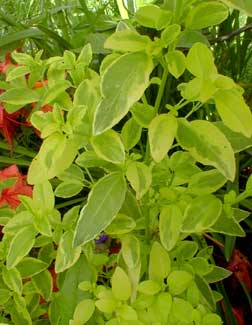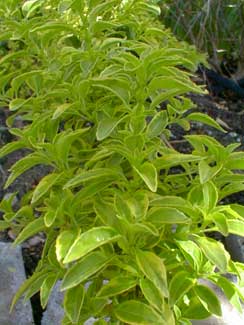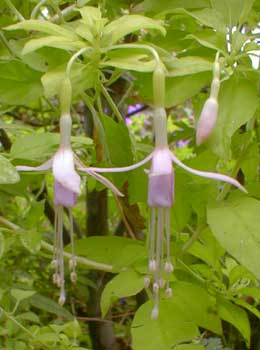
Sharpton's Hardy Fuchsia;
or, Magelan's Golden
Variegated Lady's Eardrops
"Yesterday poor Peter Rabbit died & his funeral was held with proper state. Archie, in his overalls, dragged the wagon with the little black coffin in which poor Peter Rabbit lay. Mother walked behind as chief mourner, she & Archie solemnly exchanging tributes to the worth & good qualities of the departed. Then he was buried, with a fuchsia over the little grave."
-from Theodore Roosevelt's
Letters to His Children,
1919
Letters to His Children,
1919
Fuchsia magellanica var mollinae 'Sharpton' is a dwarf fuchsia that I tragically abused for a long while. It spent nearly three years in a location that I chose for it so it would have winter protection, but it was also rather too protected from sun & rainfall, & dry shade is not what fuchsias want.
Because it was in something of an out-of-sight out-of-mind invisible location, reminding myself to get water to it wasn't working in its favor. Yet the remarkable thing is that the Sharpton's proved so extremely hardy that it about halfway adapted to its sorry position & began a struggle toward sunlight. It was behaving like a ground-creeper trying to find its way forward in the garden where there was more sun & more moisture.
 Three years after it was planted, it had become rangy & was only well-leafed at the point where it had crept over the ground into better sun. I finally took pity on it & in spring 2003 moved it to a splendid location with dappled afternoon sunlight & consistent moisture. Alas, the combination of transplant shock, too sudden a restoration into sunlight, & overall prolonged neglect caused it, for all I could see, to completely drop dead.
Three years after it was planted, it had become rangy & was only well-leafed at the point where it had crept over the ground into better sun. I finally took pity on it & in spring 2003 moved it to a splendid location with dappled afternoon sunlight & consistent moisture. Alas, the combination of transplant shock, too sudden a restoration into sunlight, & overall prolonged neglect caused it, for all I could see, to completely drop dead.It disappeared for eight months or so, then at the start of winter 2003, of all inappropriate times, it put out some new bright & variegated lime-green or chartreuse leaves, truly giving evidence for that common designation "hardy" fuchsia. It did not die back until well into winter, & it reappeared again, with its first few leaves, early in March. But it took until late in May, well over a year after it was transplanted into a fine location, to really begin to bush out & regain some size & beauty.
 Sharpton's hardy fuchsia only rarely exceeds eighteen inches tall & two foot spread. In its previous harsh area it became a completely prostrate creeping groundcover though now that it has a great location, with a slight hillside to spill down, it took on much more of upright, bushy, & semi-weeping form.
Sharpton's hardy fuchsia only rarely exceeds eighteen inches tall & two foot spread. In its previous harsh area it became a completely prostrate creeping groundcover though now that it has a great location, with a slight hillside to spill down, it took on much more of upright, bushy, & semi-weeping form.It has palest lavender-pink & white flowers similar to 'Alba' aka 'Molinae' cultivars, lasting from June or July at least through September. But these blooms are relatively few in number for this cultivar, & they hide beneath the foliage, so that the common name Ladies' Eardrops is not as descriptive for 'Sharpton' as for cultivars of this species that do have larger more visibly dangling blooms.
For the flowers to be seen to best advantage 'Sharpton' would have to be planted on an elevated ledge, & even then the beauty of the leaves outshines the blossoms by several degrees.
'Sharpton' is not the same as another molinae cultivar called 'Sharpitor,' after Sharpitor, England, where it was developed by the National Trust. 'Sharpitor' grows much more upright, with pale pink flowers unhidden by the leaves, & without variegated leaves.
We also have a "regular" variant molinae called by the common name Lady's Blush Fuchsia. It has larger leaves of normal green, & not so little overall as 'Sharpton,' plus it has the same pale lavender-pink flowers.
Though the flowers of 'Sharpton' are among the least showy of any fuchsia, it is nevertheless a beautiful subshrub, interesting for foliage which consists of small lime green leaves with yellow margins. 'Sharpton' provides a spot of brightness & color even without the showy flowers of most fuchsias.
As I have added other garden-hardy fuchsias around the yards, I never again tried to "stretch" their adaptability as I had tried to do with the 'Sharpton.' Once established they can tolerate a little droughtiness from time to time, but not as daily experience. I had also a few years back planted the fuchsia 'Little Giant' in deep dark shade, where it scarsely bloomed & never looked the least bit dramatic; when it was moved to a watered location with dappled sunlight, it immediately bushed out so much that "Little" scarsely seemed a good cultivar name any longer.
So while F. magellanica cultivars can tolerate considerable shade & occasional droughtiness, merely tolerating is not the same thing as giving them conditions in which they genuinel y thrive. I now place such hardy fuchsias in dappled-sunlight locations with regular watering, which induces bushy semi-evergreen behavior, & for almost any variety except 'Sharpton,' dense flowering from late spring until deep into autumn.
In colder climates than ours, F. magellanica hybrids & cultivars will generally loose their leaves in winter, but still thrive as die-back perennials. Here on Puget Sound they remain vibrant evergreens through much of winter, though in some years, if there is a prolonged coldsnap, they will after all die to the ground.
They are in all cases quiescent in winter & will not put on much if any new growth until just before spring, at which time the old leaves finally become spotty or otherwise look done-for. The whole subshrub benefits from a good sheering just before new spring growth begins, to do away with the scruffiness resulting from winter injury.